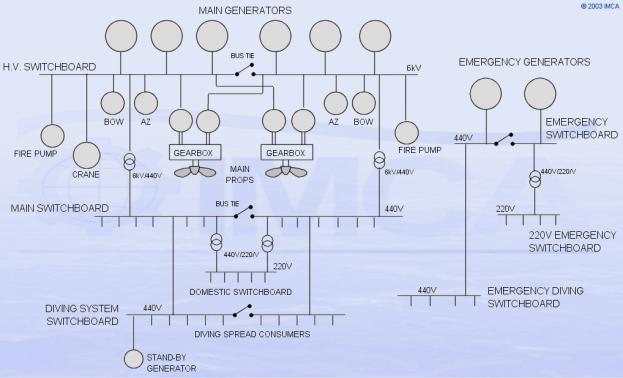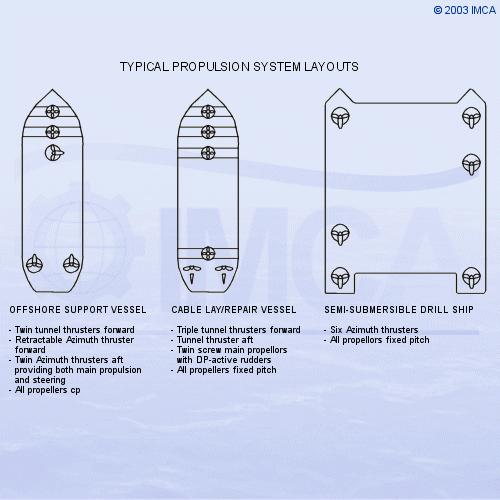
- •1 - Introduction
- •1.1 - Station Keeping
- •2 - Basic Principles of DP
- •2.1 - DP Model
- •3 - Elements of a DP System
- •3.1 - Computers
- •3.2 - Control Console
- •3.3 - Position Reference Systems
- •3.4 - Heading Reference
- •3.5 - Environment Reference
- •3.6 - Power Systems
- •3.7 - Propulsion Systems
- •4 - Position Reference Systems and Equipment
- •4.1 - General
- •4.2 - Hydroacoustic Position Reference (HPR)
- •4.2.2 - Long Baseline System
- •4.2.3 - Short Baseline System
- •4.3 - Taut Wire Position Reference
- •4.4 - The DGPS Position Reference System
- •4.4.1 - Network DGPS
- •4.4.2 - Relative GPS
- •4.4.3 - The GLONASS system
- •4.5 - Laser-Based Position Reference
- •5 - DP Operations
- •5.1 - Diving and ROV Support Operations
- •5.2 - Survey and ROV Support
- •5.3 - Seabed Tractors and Trenchers
- •5.4 - Pipelay Operations
- •5.4.1 - J-Lay Operations
- •5.4.2 - Reel-Lay Operations
- •5.5 - Rock Dumping Operations
- •5.6 - Dredging Operations
- •5.7 - Cable Lay and Repair Operations
- •5.8 - Crane Barge Operations
- •5.9 - Mobile Offshore Drilling Units (MODUs)
- •5.9.1 - DP Drilling Operations
- •5.10 - Offtake Tanker and FPSO Operations
- •5.11 - FPSO Unit Operation
- •5.12 - Other Functions and Operations Utilising DP
- •5.12.1 - Passenger Vessels
- •5.12.2 - Specialist Semi-Submersible Heavy-Lift Vessels
- •5.12.3 - Military Operations and Vessels
- •6 - DP Vessel Operations
- •6.1 - Operational Planning
- •6.1.1 - Contingency Planning
- •6.2 - The UTM Co-Ordinate System
- •6.3 - Worksite Approach
- •6.4 - Final Setting-Up
- •7 - Information for Key DP Personnel
- •7.1 - Failure Mode and Effects Analysis
- •7.2 - Classification Societies
- •7.3 - Consequence Analysis
- •7.4 - Watchkeeping
- •7.5 - Checklists
- •8 - DPO Training
- •8.1 - The Training and Experience of Key DP Personnel
- •8.2 - The Nautical Institute Training Scheme for DP Operators
- •8.3 - On-Board Training
- •8.4 - Technical Training
- •8.5 - IMCA Training Guidelines
- •8.6 - DP Logbooks
- •9 - References
- •10 - Useful Acronyms & Abbreviations

The wind sensors are important because large changes in wind speed or direction can cause major disturbances in the positioning if they are not selected or shielded. The wind feed-forward allows an immediate compensatory thrust to be applied in direct proportion to the change detected in the wind speed and/or direction.
Many DP control systems also have a wind compensation facility within the manual (joystick) control function, providing the operator with an environmentally-compensated joystick control option.
3.6 - Power Systems
Central to the operation of any DP vessel are the power generation, supply and distribution systems. Power needs to be supplied to the thrusters and all auxiliary systems, as well as to the DP control elements and reference systems.
The thrusters on a DP vessel are often the highest power consumers on board. The DP control system may demand large changes of power due to rapid changes in the weather conditions. The power generation system must be flexible in order provide power rapidly on demand while avoiding unnecessary fuel consumption. Many DP vessels are fitted with a diesel-electric power plant with all thrusters and consumers electrically powered from diesel engines driving alternators. A diesel engine and alternator is known as a diesel generator set.
Sketch 3.4 - Power Distribution on a Typical OSV
Some DP vessels comprise part diesel direct-drive thrusters and part diesel electric plant and motor-driven thrusters. A vessel may have twin screws as main propulsion driven direct by diesel engines and bow and stern thrusters electrically driven, taking power from shaft alternators coupled to the main diesels or from separate diesel generator sets6.
The DP control system is protected against a mains power failure by the inclusion of an uninterruptible power supply (UPS). This system provides a stabilised power supply that is not

affected by short-term interruptions or fluctuations of the ship’s AC power supply. It supplies the computers, control consoles, displays, alarms and reference systems. In the event of an interruption to the ship's main AC supply, batteries will supply power to all of these systems for a minimum of 30 minutes.
3.7 - Propulsion Systems
The DP capability9 of the vessel is provided by her thrusters. In general, three main types of thruster are fitted in DP vessels; main propellers, tunnel thrusters and azimuth thrusters. Main propellers, either single or twin screw are provided in a similar fashion to conventional vessels. In DP vessels where such main propulsion forms part of the DP system, propellers may be controllable pitch (cp) running at constant rpm8 or variable speed. DC motors or frequencyconverter systems enable variable speed9 to be used with fixed-pitch propellers. Main propellers are usually accompanied by conventional rudders and steering gear. Normally, the DP installation will include control and feedback of the rudder(s). Some DP vessels are fitted with modern hi-lift high efficiency rudders which enhance the vessel’s transverse thrust aft.
Sketch 3.5 - Typical Propulsion System Layouts
In addition to main propellers, a DP must have well-positioned thrusters to control position. Typically, a conventional monohull-type DP vessel will have six thrusters; three at the bow and three aft. Forward thrusters tend to be tunnel thrusters, operating athwartships. Two or three tunnel thrusters are usually fitted in the bow.
Stern tunnel thrusters are common, operating together but controlled individually, as are azimuth or compass thrusters aft. Azimuth thrusters project beneath the bottom of the vessel and can be rotated to provide thrust in any direction. Propeller drive is usually by bevel gearing from above. The whole unit may in some cases be retractable into the hull. Azimuth thrusters have the advantage that they can provide thrust in any direction and are often used as main propulsion in lieu of conventional propellers.
A podded thruster is also a type of azimuth thruster, but in this case the motor and shaft are enclosed and rotate with the thrusters below the hull. Ship rings provide the power from the vessel to the rotating pod containing the drive motor or motors.
